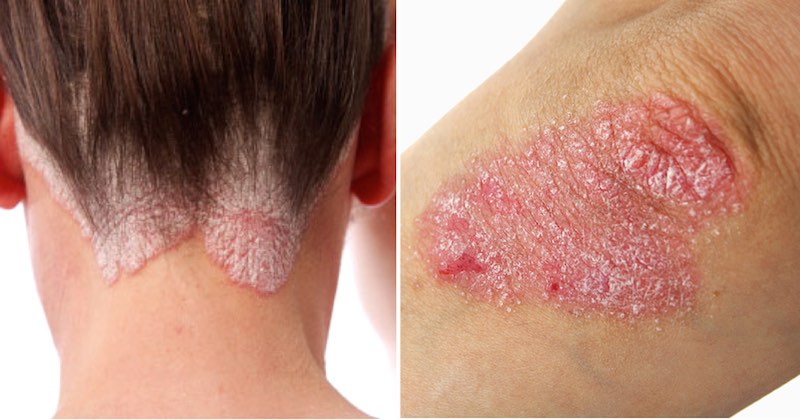How To Detoxify And Get RID Of Psoriasis Once And For All
Last updated on
Psoriasis is not permanent. Natural remedies are within your reach. You just need to be pointed in the right direction … here’s what to do.
Understanding Psoriasis
Psoriasis [pronounced sore-EYE-ah-sis] is a completely different kind of skin condition from eczema or dermatitis. It is a chronic, recurring inflammatory skin disease characterized by red patches, dry, scaly skin with distinct border between the patch and normal skin. Pain and itching usually accompany this condition.
Psoriasis is a diverse form of skin disease that may appear in a variety of forms, each with their distinct characteristics. In some sufferers, it can change from one form to another.
Symptoms of Psoriasis
Psoriasis begins most often in people aged between 10 and 40, although people in all age groups are susceptible. It usually starts with a small patch on the scalp, elbows, knees, backs or buttocks.
These patches may clear up after a few months, or may remain to grow into larger patches.

Psoriasis could be a lifelong, non-contagious skin disease. There are many forms of psoriasis. The most common form, plaque psoriasis, appears as raised, red patches or lesions covered with a silvery white build-up of dead skin cells that look like and are called “scales”.
Inverse psoriasis are mostly found under the armpits, groins, under breasts and in other skin fold areas. The lesions are very red and appear smooth and shiny, unlike plaque psoriasis.
Erythrodermic psoriasis causes the skin to become red and scaly. The lesions are like a burn, keeping the skin from serving as a protective barrier against injury and infection.
Pustular psoriasis has lesions that are large and small with pus-filled blisters (pustules) commonly forming on the palms of the hands and soles of the feet. Occasionally they are also scattered all over the body.
Causes of Psoriasis
Psoriasis occurs because of an abnormally high rate of skin cells growth. The reason for the rapid cell growth is thought to be a problem with the body’s immune system and toxicity in the blood.
A number of other factors are also thought to cause or contribute to psoriasis, including excessive stress, excess copper and keratin, incomplete protein digestion, bowel toxemia, impaired liver function, sugar, alcohol and tobacco consumption, and excessive consumption of processed foods and animal fats.
Scientists have found a possible cause of this condition. When the body makes proteins out of amino acids it has to fold the protein back on itself. This folding must be totally accurate—if not then the body is unable to make that particular protein.
Certain proteins regulate the process by which the body constantly grows and sheds skin. If one of those proteins is missing things go wrong and one of the results is psoriasis. Some people just cannot make all the proteins that are needed.
Doctors and scientists have found that Sulforaphane can help the body to make that missing protein and correct the skin growing and shedding process. Read more here: How you can get the highest amount of sulforaphane.
Diet/Lifestyle Suggestions
Skin ailments are warning signs that the body is not getting rid of toxins as it should. Psoriasis is said to be a life-long disease, but I believe that with a proper detoxification program, a total change in your dietary and lifestyle may make it short-lived.
- First of all, performing a complete gastrointestinal cleanse will help improve your condition significantly and speed up healing when you also make the following dietary and lifestyle changes.
- Limit the consumption of sugar products, animal products, i.e. fats and dairy products as they contain a certain arachidonic acid found only in animal tissues that are especially toxic for chronic psoriasis sufferers. If you can totally eliminate these from your diet, you may see much better results!
- Also eliminate tobacco and alcohol entirely as they can increase the absorption of toxins from the gut that stimulates psoriasis.
- Studies have shown that fish oils can help prevent and relieve the symptoms of psoriasis. Increasing your intake of cold-water fish, such as salmon, mackerel, herring and halibut can significantly alleviate symptoms, particularly itching, within eight weeks. If these fish are not easily available, try fish oil capsules.
- Cut down on omega-6 type vegetable oils, such as corn, sunflower and safflower oils and margarines and shortenings made from these products. But increase intake of omega-3 best found in plant-based fresh flaxseed oil. Good, rapid results have been seen on psoriasis sufferers who take 2-3 tbsp flaxseed oil daily.
- Other supplements worth taking to help speed up healing are the B vitamins, vitamin D, and a high-quality probiotics. See below for some suggestions of good probiotics.
- Avoid sources of gluten, such as wheat to help reduce the problem.

- Drink 2-3 glasses of green juices daily to help alkalize your body, cleanse the system and nourish/hydrate your cells for faster healing.
- Drink plenty of pure drinking water to flush out the toxins. See this page for your minimum requirement, then drink more than that.
- Grandma’s tip: Rub a slice of potato on the skin to soothe skin itchiness.
- Take a salt bath two or three times a week.
Reverse Psoriasis With Diet
Green juices are some of the best healing foods in the world that put our body back to balance. They remove unwanted microbes, parasites and toxins from our body, repair our cells, nourish and heal them.
Below are just some of the common greens and fruits that are less sweet that may be included into your diet, taken into consideration the points mentioned above under diet/lifestyle modifications.
Celery |
Cucumber |
Fennel |
|
Kale |
Spinach |
Beetroot |
|
Wheatgrass |
Cilantro |
Ginger root |
Lemongrass |
Chayote |
Coconut |
Guava |
Apple |
Some Suggested Combos (measurement for one portion):
- 2 green apples + 6 ribs of celery + 8-10 leaves of kale + ¼ lemon
- 2 green apples + 1 fennel + a bunch of watercress + ¼ lemon
- 1 cucumber + 1 medium-sized beetroot + ¼ lemon + a thumb-sized ginger root
- 1 cucumber + 6 ribs of celery + 4-6 radish (pungent) +¼ lemon
- Drink fresh coconut water (not packaged/bottled)
- 1 oz (1 shot) of wheatgrass juice daily + a squeeze of lemon juice
- Lemongrass-ginger tea
Learn to make great-tasting green juices.
Some of the links I post on this site are affiliate links. If you go through them to make a purchase, I will earn a small commission (at no additional cost to you). However, note that I’m recommending these products because of their quality and that I have good experience using them, not because of the commission to be made.
Comments
Leave a Reply


































 JOIN OVER
JOIN OVER
Great information, thank you. I have been suffering with awful flare ups … so change of diet is helping.
it is helpful and am going to try it